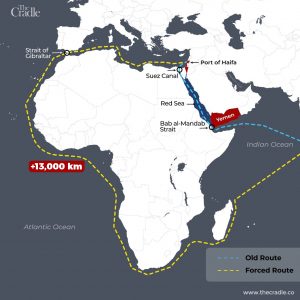Yemen has shaken the trajectory of Israel’s Gaza war by attacking ships en route to the occupation state. The US and its allies now threaten to establish a naval task force in response, a move that is likely to backfire and stoke even more conflict.

Instead of pressuring Israel to stop its brutal assault on the Gaza Strip, the Biden administration is now mobilizing Arab and western fleets – and perhaps an Israeli one as well – to safeguard Tel Aviv’s economic, political, and military interests.
Amid heightened naval operations carried out against Israel-bound vessels by Yemen’s Ansarallah-aligned armed forces, this US mobilization is taking place under the guise of upholding freedom of navigation in the Red Sea and Bab al-Mandab.
Officially, Washington claims it is doing its utmost to prevent Israel’s war from expanding into a regional confrontation, and has publicly urged Tel Aviv to tone down its indiscriminate attacks on civilians in the besieged strip.
In reality, however, the White House is employing empty rhetoric to buy Israel more time to achieve a victory in Gaza and eliminate the Palestinian resistance.
The US proposal to assemble an international naval force for Red Sea navigation protection can only be understood in the context of unconditional US support for Israel.
When National Security Advisor Jake Sullivan announced discussions on 4 December about forming a naval task force, Tel Aviv promptly heightened its threats of military retaliation against Yemen over obstructing Israeli ships and those associated with Israeli interests in the Bab al-Mandab.
US seeks a greater role in Red Sea
Rather than heed Ansarallah leader Abdulmalik al-Houthi’s repeated warnings for Washington to cease support for Israel’s war on Gaza following the Palestinian resistance’s Al-Aqsa Flood operation on 7 October, the Biden administration seems to have turned a blind eye.
Instead of pressuring Tel Aviv to prevent a regional escalation, Washington has opened a weapons air bridge to Israel that far exceeds its arms supplies to Ukraine during a similar period.
The US has even expanded its military deployment in the region, and directly confronted the Yemeni missiles and drones targeting the city of Umm al-Rashrash (Eilat) in southern Israel.
Despite two months of unprecedented carnage against Gaza’s civilians that has flipped global opinion against Tel Aviv, the US appears unwilling to confront Israel’s decision to wage a protracted war.
The White House’s focus has instead pivoted toward protecting Israel’s commercial interests in the Red Sea, and has entangled the US in forming a deeply controversial naval task force in West Asia.
Last week, after Yemen’s military campaign to halt Israeli-linked shipping gained momentum, Israel’s National Security Council Head Tzachi Hanegbi declared that “If the world does not take care of it, we will take action.”
This followed US Secretary of Defense Lloyd Austin’s discussion with his Saudi counterpart Khalid bin Salman on the “Houthi threats to freedom of navigation in the Red Sea,” earlier in the month.
Sullivan made matters more clear when he announced ongoing talks to form a maritime task force of “some kind” to ensure the safe passage of ships in the waterway.
The expression “some kind” of force indicates that Washington does not intend to limit itself to the so-called “Joint Task Force 153,” which was formed two years ago to “combat terrorist and smuggling activities” in the Red Sea and the Gulf of Aden.
This force includes 15 countries, including the United States, Saudi Arabia, Egypt, and Jordan, but does not include Israel. In fact, the new ‘task force’ looks increasingly like an American move to confront Yemen more directly, after an eight-year war its Saudi and Emirati allies failed to win.
It is also an opportunity to force Israel’s regional integration on West Asian states, by involving Tel Aviv in a military mission with broader powers, greater armaments, and of a multinational nature.

Ansarallah challenge for CTF 153
Washington intentions have been clear since at least February 2022, when the US supervised naval military exercises in which 60 countries participated, including Israel – the first time the occupation state participated in exercises alongside Arab countries with which it lacks formal diplomatic relations.
CTF 153 is the fourth force of its kind within the framework of the “Combined Maritime Force” (CMF), an alliance of multinational forces from 39 countries established in 2002 under the command of the Fifth Fleet in Bahrain, ostensibly to combat the activities of illegal actors and international terrorism in the seas.
The CMF includes three other task forces (150, 151, and 152). Among the participating countries are Australia, Belgium, Brazil, France, Germany, Greece, India, Iraq, Italy, Japan, South Korea, Norway, Kuwait, Portugal, Qatar, Singapore, Spain, Thailand, Turkey and Britain.
But according to Defense News, the US “doesn’t need to create a new task force; there is an existing task force within Combined Maritime Forces, namely CTF 153, that can provide a running start.”
This is because the CTF 153′s existing mission is to “focus on international maritime security and capacity building efforts in the Red Sea, Bab al-Mandeb and Gulf of Aden. Indeed, US and French forces confronted drones and missiles launched by the Yemenis in recent days.
However, a potential escalation in targeting Israel-associated vessels by Ansarallah could pose a significant challenge for CTF 153. Due to the substantial volume of ships traversing the waters near Yemen, from the Gulf of Aden to Bab al-Mandab and the Red Sea, the naval force would need to contend with approximately 21,000 vessels.
Geopolitical goals and energy security
Bab al-Mandab, in particular, is identified as a vulnerable point through which 12 percent of total global seaborne-trade passes through annually. This raises some important considerations for parties intent on stymying Ansarallah’s capabilities: The US, for instance, will be compelled to provide a large number of multi-mission military ships across expansive water bodies.
The Defense News report stressed the necessity of Israel’s presence alongside Egypt, Saudi Arabia, the UAE, and Bahrain in the proposed naval force, in addition to the G7 countries that include Canada, France, Germany, Italy, Japan, and Britain.

Washington will need to include a large number of regional countries – and even distant ones – into this force, which will effectively lead to the militarization of entire maritime areas from the Mediterranean Sea to the Suez Canal, the Gulf of Aqaba, the Red Sea, the Gulf of Aden, the Arabian Sea, all the way to the Persian Gulf.
As the US competes with China and Russia, its overarching goal is to assert dominance over international corridors, fortify energy security, and manage geopolitical conflicts in West Asia. However, the US escalation to safeguard Israel’s interests raises the specter of igniting a regional war, contradicting Washington’s claims of seeking to avoid such a scenario.
This heightened tension raises concerns about potential US attacks on Yemen, jeopardizing the fragile truce that halted the seven-year war led by Saudi Arabia and the UAE. It also risks undermining the UN-mediated efforts to consolidate the ceasefire.
According to news reports, the US is already applying pressure on Riyadh to delay the signing of a peace agreement with Yemen. Washington is instead urging the Saudis to renew their confrontation with Yemen by joining the expanded maritime protection task force.
Such involvement implies US, western, Arab or Israeli military actions in the aggression against Yemen, amplifying regional resentment against perceived US bias in favor of Israel.
‘Containment coalition’
In response to the challenge posed by Yemen to the US-Arab-Israeli alliance, various ideas and proposals are emerging, including:
Targeting missile and drone launch sites and radar installations in Yemen; Reclassifying Ansarallah as a terrorist organization and imposing sanctions, including an arms embargo;
Strengthening the armament of the “Coast Guard” affiliated with the UAE-backed Southern Transitional Council (STC);
Monitoring Iranian naval forces’ movements and establishing an air and missile defense network in the region;
Exploring the utilization of Israel and Saudi Arabia’s capabilities to form a “containment coalition,” as suggested by The Washington Institute.
The Biden administration’s moves, presented as efforts to safeguard international interests, makes one wonder about the real motives for creating a new naval task force and the possible impact on peace and stability in West Asia.
As the US chases its strategic objectives, there’s a genuine concern that it could destabilize an already unstable geopolitical situation, bringing in other great powers into the equation.
It is important to remember the maxim that no action goes without a reaction. Whatever the American and Israeli plans to confront Ansarallah, they will face a response. If history is any judge, Washington’s foreign adventures are rife with unintended consequences that bolster its foes.
If the plan is to destroy Yemen’s military capabilities, Sanaa will respond harshly and could well “close the Red Sea for years,” official Yemeni sources tell The Cradle. The sources say that Ansarallah sent its “defensive threats” to Washington in response to US threats they received through intermediaries.
Accordingly, Washington and Tel Aviv’s options appear very limited in confronting Yemen.
By Khalil Harb
Published by The Cradle
Republished by The 21st Century
The views expressed in this article are solely those of the author and do not necessarily reflect the opinions of 21cir.com.
